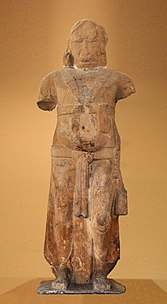|
Parkham Yaksha
The Parkham Yaksha is a colossal statue of a Yaksha, discovered in the area of Parkham, in the vicinity of Mathura, 22.5 kilometers south of the city.[1] The statue, which is an important artefact of the Art of Mathura, is now visible in the Mathura Museum. It has been identified as the Yaksha deity Manibhadra, a popular deity in ancient India. DateThe Parkham Yaksha is datable to period 200 BCE – 50 BCE on paleographic and stylistic grounds.[2][3] It has also been dated more precisely by Heinrich Lüders, who gives it a mid-2nd century date, and Sonya Rhie Quintanilla who dates it to circa 150 BCE.[1] InscriptionThe statue is 2.6 meters tall, including its base of about 30 centimeters.[1] The badly corroded inscription in early Brahmi script on the top side of the base reads:
This inscription thus indicates that the statue represents the Yaksa Manibhadra, and the title "Bhagavat" ("Lord" or "Holy One") suggests that the statue represents a divinity in its own right, which was the subject of worship, independently of Buddhism or Jainism with which it was later associated.[1][5] StyleThe analysis of the statue has suggested that the Parkham Yaksha probably held his left arm akimbo, while holding a bag filled with square coins, as seen in the Manibhadra statue of Pawaya.[1] According to John Boardman, the hem of the dress is derived from Greek art. Describing a similar statue, John Boardman writes: "It has no local antecedents and looks most like a Greek Late Archaic mannerism". Similar folds can be seen in the Bharhut Yavana.[6] The Parkham Yaksha is one of four known occurrences of the Yaksha Manibhadra in inscriptions: one in Parkham near Mathura, one in Pawaya near Gwalior, one in Masharfa and one in Bhītā near Kausambi.[1] It appears Manibhadra was considered as a protector of itinerant merchants, a provider of wealth, and a protector against smallpox.[1]
See alsoReferences
Sources
|
||||||||||||||||||




![Parkham Yaksha, detail of the "Hellenistic" drapery.[6] 150 BCE[1]](http://upload.wikimedia.org/wikipedia/commons/thumb/f/f1/Parkham_Yaksha_Hellenistic_drapery.jpg/106px-Parkham_Yaksha_Hellenistic_drapery.jpg)
